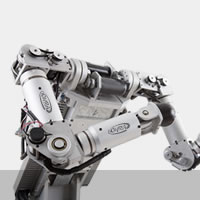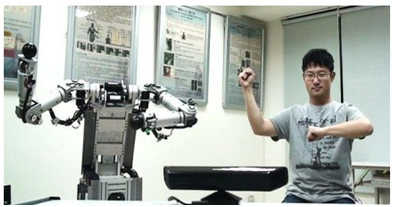Dual Arm Robot
Application of Anthropomorphic Dual Arm Robot: Human Motion Imitation
In recent years, the development of human robot interaction in service robots has attracted the attention of many researchers. In order to let humanoid robots have similar behavior with human, motion planning is crucial. However, planning human-like motions for robots is very complicated because it needs to handle multiple degrees of freedom (DOFs) simultaneously. Learning by demonstration is an intuitive and efficient way to let a humanoid robot learn a variety of human-like motions. The idea is to generate human-like motions by extracting information directly from human motion via a motion capture system, and it simplifies the process of programming and learning complex motions.

In order to avoid jerky and non-smooth motion, we implement online trajectory generator, then we can add acceleration and velocity limitation when planning trajectories. Besides, self-collision must be avoided too. By concept of virtual spring, a repulsive force will generate between two arms when they are too closed to each other. Last but not least, a limitation on force outputted by motor is added, it makes the robot seem to be safer when moving.
Hence, after concerning the above-mentioned issues, our main objective is to make the robot be able to imitate human’s motion by de human demonstration in real time (Fig. 1). Since the robot can be taught by human without complex programming, in the future, it can be used to teach robot to do cleaning or assembling tasks. Moreover, it can be used by doctor or physiotherapists to help patients to do upper limb rehabilitation.

Fig. 1 The robot imitates human motion by human demonstration